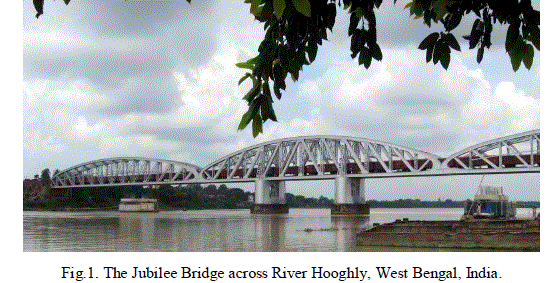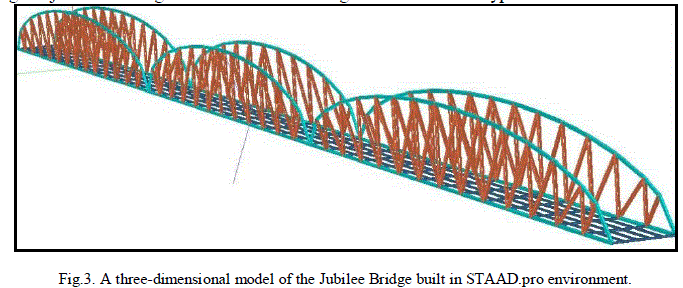ISSN ONLINE(2319-8753)PRINT(2347-6710)
ISSN ONLINE(2319-8753)PRINT(2347-6710)
Kishore Ch. Misra1, Debojyoti Panda2 and Soumya Bhattacharjya3
|
| Related article at Pubmed, Scholar Google |
Visit for more related articles at International Journal of Innovative Research in Science, Engineering and Technology
Fatigue life assessment of a century old railway bridge in India namely Jubilee bridge has been calculated following Eurocode 3 by using the Palmgren-Miner Rule. It has been observed that the remaining fatigue life of different members and bearings of the bridge has been exceeded in 2014 or on the verge of exceeding. Considering uncertainty and maintenance point of view the bridge, especially the outer bearing would be in more critical with respect to fatigue damage. Thus, it can be safely concluded that the bridge is no longer safe from fatigue point of view.
Keywords |
| Fatigue life assessment, Palmgren-Miner Rule, Railway bridge, fatigue damage |
INTRODUCTION |
| Fatigue is the progressive and localized structural damage that occurs due to the action of fluctuating stress on a structural component, when it is subjected to cyclic loading for a sustained period of time. Machine parts as well as a large number of structural systems like bridges are frequently subjected to varying stresses and it is important to know the strength of the material as well as its tentative life at an acceptable level of performance under such conditions. In the past, the collapse and failure of an appreciable number of structures have been attributed to fatigue failure. In India itself, an alarming number of bridges are in service that have crossed their design lives and are highly vulnerable to fatigue damage and failure. Keeping this in mind the large risk that they pose to mankind in terms of life risk and loss of livelihood, besides economic ramifications, it is absolutely necessary to assess the health of these structures systematically from the fatigue point of view so that proper remedial measures can be taken beforehand to preclude any accident due to the same. |
OBJECTIVE |
| The objective of the present investigation is to perform a detailed fatigue life assessment of the Jubilee Bridge in West Bengal, India (Fig. 1). The motivation behind this study lies in the fact that the bridge, which was opened to railway traffic in the year 1887, is still in service and is an important railway bridge connecting the places, Bandel and Naihati, across the River Hooghly and is flanked on either side by Garifa and Hooghly Ghat Railway Stations. Since the design life of this bridge has already expired, it is absolutely necessary to assess and justify whether the bridge should be left in service as it is (i.e. continuing with standard maintenance and monitoring) or additional remedial measures needs to be taken from an engineering point of view to address any potential or existing damage that has been caused or aggravated by fatigue. |
METHODOLOGY |
| A. General Information |
| The single track 366 m long railway bridge was built in 1885 and opened for traffic in 1887. It is still in use today. The bridge was fabricated and erected by James Goodrich & Co. Engineering & Founders. The bridge is of riveted cantilever truss type and composed of two equal trusses. The structural system of each truss is shown in Fig.2. In 2013, after over 125 years of service, there is a motivation for assessment of the fatigue life of the bridge since the bridge has reached the end of its design working life. Therefore, an assessment is carried out to determine the residual life of thebridge. |
 |
| It has to be noted that, in old bridges fatigue damages occur primarily in the longitudinal and cross-girders of the bridge and its connections. However, in this case study it is assumed that these more critical bridge members have been replaced and the aim of the following investigation is to examine only the members of the two trusses and the bearing of the bridge. |
| B. Modelling |
| A three-dimensional model of the Jubilee Bridge is prepared using the software STAAD.pro and is shown in Fig. 3. The sections used in different members are depicted in Table 1. The support conditions of the bridge model have been assigned to be hinged in nature for the sake of simplicity, as detailed information to assess the degree of partial fixity at the supports was not available. |
| C. Loading and Support Conditions |
| Primarily the load data of four types of railway goods rakes [1-3] have been considered for the purpose of load calculation, the details of which are as follows :- |
| 1) Taken Over Coal rakes (Composition – 2L + 55 BOXN, rain Length – 624.151 m,Total Weight – 5140 t) |
| 2) Taken Over Other rakes (Composition – 2L + 40 BOX,Train Length – 583.726 m, Total Weight – 3551 t) |
| 3) Made Over Loaded rakes (Composition – 2L + 40 BOX, Train Length – 583.726 m.Total Weight – 2902 t) |
| 4) Made Over Empty rakes (Composition – 2L + 40 BOX, Train Length – 583.726 m,Total Weight – 1036 t. |
| The axle loading arrangements for the two different compositions of rakes (2L + 40 BOX and 2L + 55 BOXN) are shown in Fig. 4. |
| D. Post-processing of the analytical results |
| The maximum and minimum axial stresses that the members and the bearings of the truss are subjected to, due to the cumulative action of the moving loads and the self-weight of the structure are analysed from the results of the computational analyses for each of the aforementioned four types of rakes at different positions of the moving load. It is observed that of all the members of one of the two trusses that are symmetrical in nature, the rafter element (shown in red in Fig.2) is the most critical. This is concluded on the basis of the computational results which reveal that these members are being subjected to the greatest axial stress range for all the four types of rakes that have been considered. |
 |
| E. Selection of the S-N Curve |
| Since the entire structure was built using rivets, the detail category of 71 depicted in IS code [4] is chosen to determine the number of cycles to fatigue (N) corresponding to the maximum stress ranges for each of the four types of rakes. |
| F. Formation of the Stress Range Spectrum |
| On the basis of the annual traffic load data of the bridge (Fig.5) and the axial stress values of the critical member obtained from computational analyses, the number of crossings and the stress range spectrum is computed. Similarly, stress range spectrum for the bearings, of both the inner and end supports, are calculated from the maximum and minimum bearing stress values. These were obtained from the resultant reaction forces acting on the bearings at the supports. To take into account the dynamic magnification of the stresses due to the velocity of the moving rake, a dynamic factor ( ) equal to 1.08 and 1.17, has been imposed on the bearing and axial stress ranges respectively, corresponding to the data available from literature [5]. The effect of the secondary stresses on the members (K),arising due to differences in the structural system as well as because of the eccentric connections, influence of assembly, etc., |
 |
 |
| G. Calculation of the remaining fatigue life |
| 1) Calculation of the remaining fatigue life of the most critical truss member |
 |
 |
| It can be further noted that annual traffic load data for only past five years were available from the Railway archives. Rest of the traffic load data have been rationally assumed from the discussion with railway officers. This may lead to a gross overestimation of the total amount of loads that the bridge has been subjected to in the past. Owing to these gross and significant assumptions, the entire fatigue life assessment is approximate in nature and only a probabilistic analysis of remaining fatigue life would provide the more rational remaining fatigue life of the bridge. |
CONCLUSION |
| Fatigue life assessment of a century old railway bridge in India namely Jubilee bridge has been calculated following Eurocode 3. It has been observed that the remaining fatigue life of different members and bearings of the bridge has been exceeded in 2014 or on the verge of exceeding. Considering uncertainty and maintenance point of view the bridge, especially the outer bearing would be in more critical with respect to fatigue damage. Thus, it can be safely concluded that the bridge is no longer safe from fatigue point of view. In view of this fact, it is recommended that the Railway authorities take immediate action by adopting requisite remedial measures to either replace the failed or potentially failed members and bearings of the bridge or adopt suitable structural retrofitting measures to restore the bridge to a condition where an acceptable level of service could be expected from the bridge with a high degree of confidence.Since the data required for the detailed fatigue life assessment of the bridge was mostly unavailable or inaccessible from the Eastern Railway archives, we had to rely mostly on assumed data and quite a few simplistic assumptions for the requisite analysis. As a result, there is a large degree of uncertainty in the conclusion that has been obtained from this investigation. In order to account for this uncertainty in a proper manner, Probabilistic Fatigue Life Assessment of the Jubilee Railway Bridge may be performed in the future. This will allow us to gauge and assess the health of the structure, from the fatigue point of view, for different degrees of certainty and reliability and take necessary measures with a greater level of confidence. |
ACKNOWLEDGMENT |
| The authors are grateful to Mr. Phalguni Biswas and other officers of Sealdah Division, Eastern Railway, India. |
References |
|